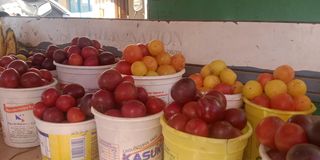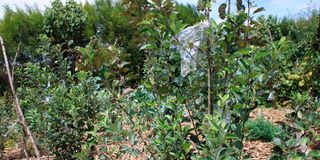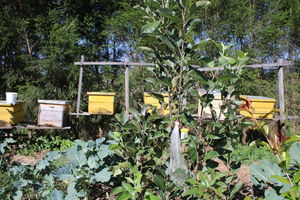Climate crisis forces Nyandarua plum farmers to shift to apples as crops fail

Plums fruits for sale at Nyahururu market on January 22, 2025. The effects of changing weather patterns have dealt a severe blow to plum farmers in Nyandarua County.
What you need to know:
- In previous seasons, markets and streets would overflow with affordable, highly perishable plums during the December-to-March harvest period.
- Today, the landscape tells a different story: barren trees stand where abundant orchards once thrived, and the familiar sight of broker trucks in Kinangop, Kipipiri, and Ndaragua has vanished.
The effects of changing weather patterns have dealt a severe blow to plum farmers in Nyandarua County, transforming a once-thriving industry into a struggle for adaptation. In previous seasons, markets and streets would overflow with affordable, highly perishable plums during the December-to-March harvest period.
Today, the landscape tells a different story: barren trees stand where abundant orchards once thrived, and the familiar sight of broker trucks in Kinangop, Kipipiri, and Ndaragua has vanished.
The impact extends beyond agriculture, creating a ripple effect throughout the local economy. According to the Nyandarua County Economic Survey, the plum industry contributed approximately Sh150 million ($1.1 million) annually to the local economy between 2018-2022, supporting over 5,000 smallholder farmers and their families. The current decline threatens this economic foundation while simultaneously depriving communities of a crucial nutritional resource.

Flourishing apple plants in Ndaragua Constituency. Nyandarua county government is promoting apple farming as a climate change mitigation measure.
Apart from its commercial value, the fruit is highly nutritious with a number of vitamins, including vitamin, A which is critical for young children and breastfeeding mothers.
"Scarcity of this fruit is a threat to human health, it shows how the effects of climate change are affecting health and nutrition. Plums are rich in vitamins A, C, and K as well as calcium and potassium, among other trace elements. Each type of fruit is produced at a different season of the year, effectively sustaining the nutritional needs of a family throughout the year. If one type of fruit fails, then it means that many families are likely to miss out on some nutrients. We hope that other fruits are not as adversely affected by the weather patterns this year," says Ms Emma Kaberi, a nutritionist based in Nyahururu town.
The impact on individual farmers illustrates the crisis' human dimension. Mr Reuben Waweru from Kinangop, whose 30 plum trees previously generated Sh72,000 per season, now faces an unprecedented total crop failure. Meteorological data reveals the culprit: the region experienced unseasonable rains and cold spells during critical flowering periods, with rainfall patterns shifting dramatically from historical norms. Records show that while the area typically received 800mm of annual rainfall spread across predictable seasons, recent years have seen irregular patterns exceeding 1,200mm annually, with rain falling during traditionally dry periods.
Ms Wambui Kagotho's experience in Shamata, Ndaragua, reflects a broader trend. Agricultural records indicate that plum yields in her area have declined by 20 per cent annually over the past three years, culminating in this year's complete failure. Market data shows prices soaring from Sh50 to Sh150 per kilo at the Nyahururu open market, making this traditionally accessible fruit a luxury item.
“This was a bad year for us. We had no fruits. By now, I would be making some good money from plums after selling to brokers and at Nyahururu market,” says Ms Wambui.
The economic impact reverberates through the community. Local hospitality industry data reveals a 40 per cent decrease in seasonal business activity during traditional plum harvest periods.
“With a good harvest, eateries and lodgings record improved business. Last year, I had at least 75 per cent hotel bookings, but there are no bookings this time. Plums buyers gave us some good business,” says Mr Francis Mwaura, a hotelier in Shamata.
However, amid these challenges, the region is witnessing an agricultural transformation. Leshau Ward Agricultural Officer Anthony Wangai explains that while traditional fruits decline, new opportunities emerge. Temperature data shows the region's average annual temperature has risen by 1.2°C over the past decade, creating conditions suitable for previously unsuitable crops like avocados.
“Traditionally, four types of fruits grow in Nyandarua - plums, pears, cherries and apples. But as climate change strikes, you will realise that these traditional fruits are also vanishing or their production naturally decreasing. But at the same time, new fruit trees that were never grown are now doing well. We have noticed a trend where trees like avocados that prefer hotter areas are now doing very well in Nyandarua, a clear testimony of climate change,” explains Mr Wangai.
Based on a comprehensive 10-year weather pattern analysis, Agriculture Executive Francis Miring'u says the county has implemented a diversification programme. The centerpiece of this initiative is a Sh26 million investment in apple farming, chosen for its resilience and research backing.
Economic projections support this transition. While a plum tree generates approximately Sh2,400 per season, apple trees can yield up to Sh6,000 each. The county's partnership with Kenya Plant Health Inspectorate Service-certified seedling propagators ensures farmers receive climate-appropriate varieties, with research indicating a 85 per cent success rate for grafted specimens.
“Apple farming is a double win for our farmers. The investment goes hand in hand with beekeeping since apples produce a lot of flowers, it’s also a way of environment conservation,” says Nyandarua Governor Kiarie Badilisha.
On plum production failure, Mr Wangai explains that fruit trees have a dormancy period between May and early July, and, when rains come at the wrong time, the trees become more vegetative instead of shedding leaves, thus affecting the production cycle.
“If unexpected rains arrive and trees don’t shed their leaves before flowering, the flowering is delayed, impacting production and potentially skipping a season. You’ll also notice that unlike high-value apples, which farmers carefully tend to, most farmers don’t cultivate pears and plums commercially with timely irrigation and inputs,” states Mr Wangai.
He adds that the county government settled on apple farming as an alternative crop since researchers are studying the crop.
“Being a high-value crop, researchers are working day and night on apples, unlike pears and plums. We have new technologies every other time in favour of apple farming. New climate change adoptive apple varieties are getting developed by researchers, and that is why Nyandarua government resolved to promote the crop, and of course after several trials to establish best varieties for the county,” says Mr Wangai, adding:
“With ongoing research work on apples, the grafted varieties will beat the vagaries of weather. Farmers should only buy seedlings from certified propagators. That way, chances of massive crop failure due to climate change-related factors are minimal.”
Environmental considerations also factor into the transition from plums to apples. Mr Joram Mathenge, a conservationist with Kiangure Springs Environment Initiative, notes that the shift extends beyond Nyandarua. Data from neighbouring Nyeri County shows a 30 per cent increase in fruit tree cultivation in traditional tea and coffee growing areas over the past five years, with avocado and mango plantations increasingly replacing tea bushes around the Aberdare Forest.
“Farmers in Nyeri’s cold areas traditionally known for coffee and tea growing are either intercropping the cash crops with fruit trees or uprooting the crops to replace with avocado, mangos and oranges. Areas around Aberdare Forest were previously dominated by tea bushes, but that is drastically changing. We now have avocado plantations replacing the tea bushes,” notes Mr Mathenge.
Climate change isn't just altering weather patterns – it's reshaping agricultural traditions, economic systems, and community relationships with the land.





